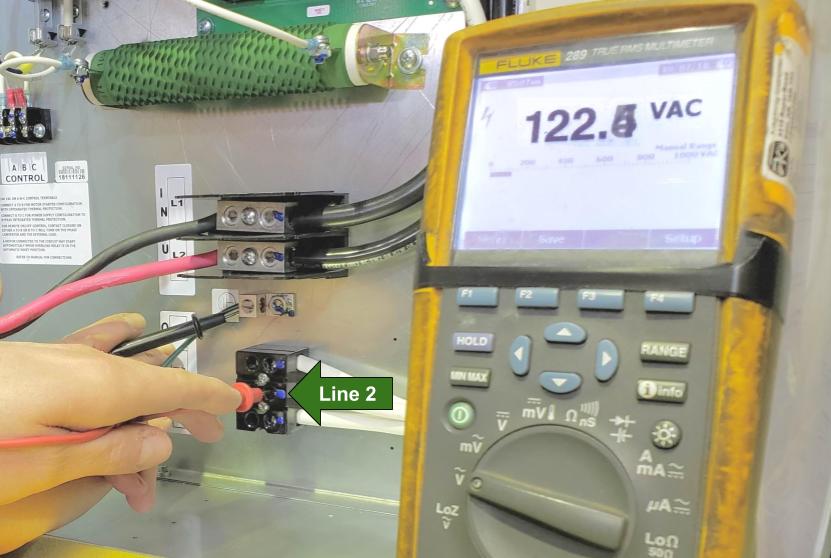We get asked all the time, “why is the voltage of the one line so much higher than the other two?” All traditional phase converters are high leg delta. This means that when using your meter you will measure 120 volts to ground on two of the three lines, but around 240 volts to ground on the third. This is perfectly normal and will work just fine for most motor loads.
Here are some pictures of what you might be seeing.



Traditional phase converters create only the 3rd line. The other two lines are left untouched.
In a phase converter, the two single-phase lines from the utility pass through untouched. After going through the converter, they will remain at the same voltage and will still be 180 degrees out of phase from each other.


The phase converter will add line 3. This is called the “manufactured leg”. If you measure this 3rd line to the ground then it will be much higher than the other two lines. This is totally normal.

The phase converter doesn’t create a new “reference” to ground. The only thing the converter does is create line 3 a.k.a. the “manufactured leg”.
In your single phase electrical panel, line 1 and 2 have a neutral which is bonded to ground ( usually the water or gas line) and in turn gives you your reference to ground.
When you measure to ground from either of these two lines you will see 120 volts. However, when you measure line 3 to ground, then you are actually referencing the ground that is between line 1 and 2 so it makes sense that you would get a different reading.
This type of electrical configurations is often referred to as High Leg Delta. High leg delta electrical services can still be found in older industrial and rural locations.

This 3 phase utility configuration is called “high leg delta” because the triangle looks like a delta Δ and line 3 (a.k.a. leg 3) is at higher voltage potential to ground than the other two lines.
The Line-to-Line Voltages are All The Same
If you were to measure line-to-line, then you will see that they are all the same and will be about 240 volts phase-to-phase.



The Line-to-Ground Voltage is High for Line 3
If you were to measure line-to-ground, then you will see 120 volts to ground on lines 1 and 2, but 240 volts to ground on line 3.



Does it Matter?
Most 3-phase loads don’t care about the line-to-ground voltage, they only care about the line-to-line voltage.
All standard phase converters will put out a three-phase voltage based on the utility voltage you supply them. There is a very good possibility you will be supplying the converter with 240 volts AC single-phase so you will get 240 volts AC three phase out.
You will need to confirm that your equipment can and will operate at 240 volts AC three-phase. If your equipment requires a different voltage you would have to install a transformer after the phase converter to step the voltage up or down to match the voltage requirements of your machines.
All phase converters are high leg delta so if the nameplate shows that it requires a three-phase four-wire circuit then you will need to use an isolation/distribution transformer to create a real neutral at a zero potential and balance all three phase voltages to ground.
CAUTION!!! – The place where this is important is when you are hooking up equipment that references ground. CNC machines and electronics have been known to have issues with this.
Summary
In summary, it is totally normal to have the manufactured 3rd line read much higher to ground than the utility lines 1 and 2. Most equipment does not care about this because most equipment doesn’t reference ground — it only references the potential between the lines. Special care needs to be taken when hooking up equipment that needs to reference ground, like electronics or CNC machines.
